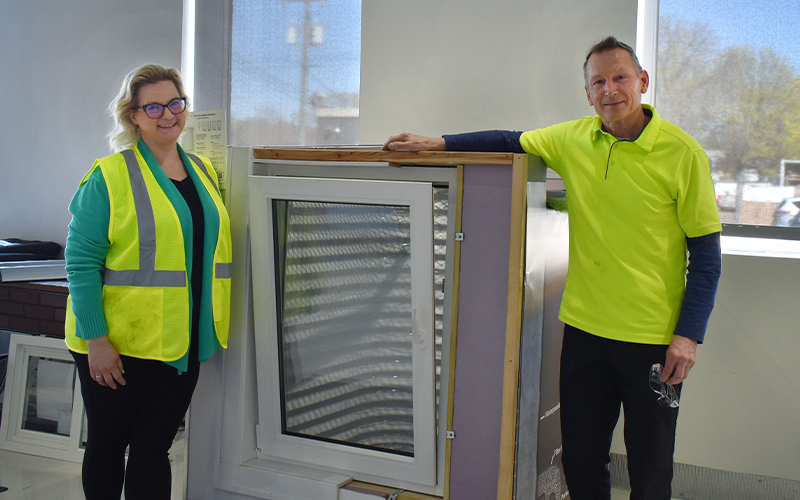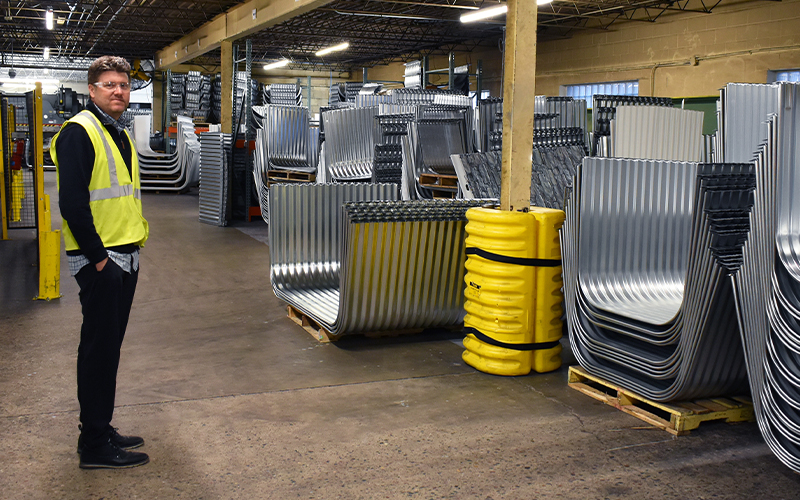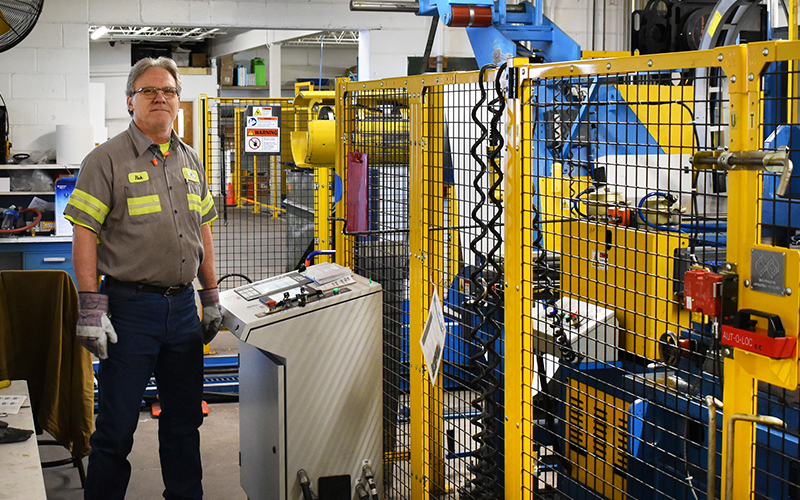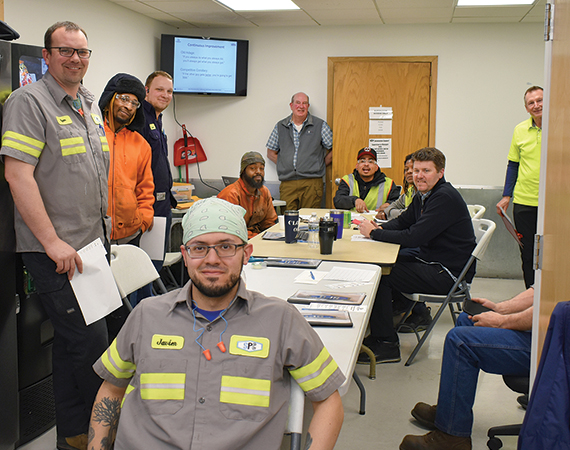After nearly 140 years in operation, St. Paul Corrugating Company (SPC) was poised for fresh growth. But there were some concerns. Different functions at the company were siloed, threatening its ability to pursue new opportunities for its diverse line of residential window well products.
Hugh Burhans, president and owner of Columbia Heights-based SPC, knew it was time to take action. The entire staff of 20-plus people, from shipping and assembly to leadership, needed to change in order to grow the business.
Bob Arvold, an Enterprise Minnesota business development consultant, observed other potential obstacles to growth. As a small business, SPC lacked a dedicated human resources person who defined job responsibilities and linked compensation to performance. That resulted in a staff “that lacked understanding of how their jobs tie to the company’s strategy and goals,” he says.
“Hugh has always had a desire to create a positive culture of communication,” Arvold says. But “what he needed was structure to give employees the opportunity and skills to build accountability in their respective areas.”
A 50-year veteran of SPC, Burhans understood that it would be more effective to bring in outside expertise to make the necessary changes. He retained Enterprise Minnesota to guide key staff through leadership development and bring more structure to its human resources functions. And with these efforts to get back on track, the company is now growing.

“There’s no question it’s been a good investment of time and dollars spent, which I’m happy to say. You’re not buying a new piece of equipment or adding on to the building — you’re basically trying to invest in your human capital,” Burhans says. “The bottom line is, if I can’t have an organization that’s running in top form, it limits my ability to go out and get more business. You are nothing without your people, and I would add that people aren’t much without a good business or a good culture — you need both.”
Before working with Enterprise Minnesota, Burhans would have said that SPC paired a family-oriented culture with a propensity to occasionally fly by the seat of its pants. Many of the staff are third-generation employees with long tenures who have helped the company thrive for decades. Now those attributes have been burnished with a more professional glow, from the way staff communicate with each other to how employees receive feedback from leadership.
Early results from the Enterprise Minnesota consulting have been positive, says Jeremy Thornburgh, who joined SPC in 2021 to lead sales and account management. To start, it helped the company identify some unrecognized talent who stepped into leadership positions. “We have a really good crew right now,” he says. “We’re here and focused on one goal and realizing that everyone has a role in achieving the goal of getting orders out and satisfying customers.”

Metal to its core
SPC has long operated in the realm of metal fabrication. Its niche lies in manufacturing products for basements and foundations, particularly focused on egress window wells. From galvanized window wells to ladders, covers, and grates, the company’s Lux-Right™ brand is sold through wholesale distribution. Its product menu of 250 options also includes egress window systems featuring energy-efficient tilting windows.
Its roots date back to 1885, when two French-Canadian cornice makers set up shop in St. Paul to develop architectural metal products. Its early business involved fabricating sheet steel and other metals for contractors and builders in the region. SPC kept up with the evolving times, adding corrugated metal, ornamentation, steel ceilings, and other roofing lines to its product assortment.
In the early 20th century, SPC honed its craft in residential metal, producing garages and other components of manufactured homes sold in the Sears, Roebuck & Co. catalog. It also developed metal window well products and stayed on top of advances in metal roofing. According to a 1943 article in Snips magazine, the company was a pioneer in sheet metal fabrication for the building, highway, and engineering industries.
While pausing its regular work to contribute to World War II efforts, St. Paul Corrugating ran advertisements targeting homebuilders across the country. It read: “When peace returns, look to us again for ample stocks of Lux-Right Areawalls, Yellow-end Culverts, But-N-Tite Roofing, Skylights and Ventilators, rain-carrying equipment, and special sheet steel fabrications.”
Post-war, a new owner moved the company’s operations to Columbia Heights, where it operates out of two neighboring buildings. SPC’s residential building egress business really took off about two decades later as building codes started requiring basement egress access.
“The basic window well had been in existence since the 1900s, but the building codes forced a change in our product. It was an opportunity for new growth,” Burhans says. “The code was adopted state by state over the last 30 years. In the 1990s and 2000s, the code was a primary driver of our new product development.”
Over time, SPC focused on the egress opportunity, developing a vertically integrated business model. To eliminate logistics headaches and costs, the company sells solely to distributors. They supply SPC products to hardware stores, lumberyards, big box retailers, and building supply companies.
SPC has been steady and successful, owing to its loyal customer base and investments in new technology, including robotics. Though the company was humming along, there was room for improvement, Burhans says. In recent years, employee relations started getting rocky as veteran staff retired and new employees joined the team. Everyone wasn’t always on board with various changes, and communication among team members eroded.
Burhans came to understand that an outside consultant like Enterprise Minnesota might be more effective in instituting the changes he wanted to see. “I needed to take myself out of the whole culture change and bring in someone with professional HR skills to break down those barriers,” he says. “We have opportunities — and our inability to create some of these changes could jeopardize our growth.”
Adding a dose of structure
In working with Enterprise Minnesota, Burhans’ goals included incorporating additional structure and processes that would get employees working from the same playbook. He also sought more uniform ways to incent strong performances and compensate staff.
Nicole Lian, an Enterprise Minnesota business growth consultant, started by facilitating a custom leadership development program to foster effective communication among SPC staff. It was eye-opening for many employees to learn about their own and others’ distinctive leadership styles, based on Tracom’s Social Styles assessment. Participants also engaged with techniques for recognizing and accommodating their co-workers’ mix of styles.
When Lian started this work in early 2022, several people reported a culture that was lacking in trust, openness, and honesty. Much of the leadership development, focused on front-line supervisors, addressed essential skills and interpersonal communications. She helped employees develop strategies to bring a more professional tone to interactions among the team.
“It had been a ‘do as I say, and just get it done’ culture. Coming into SPC and really getting to know people and helping them realize that you can give individuals inspiration to want to do really good work and want to be here by listening to them, teaching them — that really helped,” Lian says. “They became cognizant that they need to work on the business as opposed to just working in the business. By taking a breath and putting some things in place, I’ve seen this huge turnaround.”

That shift has been apparent to Rick Kramber, too. He came onboard at SPC in 2020 as the production supervisor, moving into the role of operations supervisor in 2023. Initially, Kramber saw a company that was investing in itself with new machinery and trying to make improvements. Yet some people lacked information about their job responsibilities while others were getting direction from too many sources.
“The difference from when I started to where we are today with the improvements that have been made, it’s beginning to look and feel more professional,” Kramber says. “SPC is heading in one direction, instead of all different directions. And now when I leave most days, I feel like we have made a difference.”
After implementing the leadership development program, Kramber notices a difference in himself, too: “It was such an eye-opener for me. If I could have known what I learned about leadership styles 40 years ago, my life in the manufacturing world and management positions would have been so much different. Learning my leadership style as others see me [compared to] where I saw myself was the most important thing I could have learned about myself, and that is something anyone in a leadership position needs to know.”
For example, Kramber appreciates having better techniques for interacting with other people. “It just seems to be more free and non-confrontational. I believe that was the one thing I was missing in my career,” he adds. “Once you have that and learn how to work with other styles, it makes you feel like some of the weight of the job is lifted off your back.”
Pay for performance
When Sue Swanson joined SPC in 2019 to take charge of marketing operations, she saw that the company needed to add more structure to its small business culture. She was accustomed to working at 3M, a much larger company that had defined roles, responsibilities, and a regular process for employee reviews. “It was a big culture shift,” Swanson says.
She was happy that Lian would be augmenting some of the HR changes Swanson started. In 2023, Lian launched the second phase of the consulting work, completing a project to document all of SPC’s processes and identify which position/person was responsible for each step. Lian deployed the RACI system to identify which roles are responsible, accountable, consulted, or informed for each task. Then Lian and SPC staff developed job descriptions for every position with clear expectations for the required level of involvement.
“Hugh is trying to transform the company with processes and personnel in place to scale up to a larger volume. We went through the process of getting buy-in and understanding what the transformation will be,” Swanson says.
Lian also helped SPC implement performance management policies and procedures. That meant introducing a mechanism for year-round performance management, compared to one-time, annual reviews. The company is in the process of instituting a formal performance management cycle that is tied to compensation. Using the plan, develop, monitor, review, and reward template, SPC started with 360-degree reviews of the office staff and team-based reviews for everyone else. Employees also reviewed themselves.
“During the individual review sessions, we found success in having key leadership and stakeholder individuals in the conversation, and we worked to keep it very proactive and positive. We were having very open and honest conversations about what employees are doing very well, and other areas where we might not have seen strong performance,” Lian says.

This activity was successful thanks to SPC leaders’ enhanced leadership and communication skills that they developed during Lian’s first session. Then the group would ask individuals about their goals, what they liked and wanted to continue doing, and what they might like to do differently. “Through that we got a full list of feedback that we were able to gather and put some action toward,” she adds.
The review system allowed company leaders to give positive feedback where it was due and address any nagging performance issues. SPC provided constructive feedback, gave employees opportunities to address it, and asked how company leaders could help them improve. Though those conversations can be difficult, Lian says, they provide employees with clearly defined expectations for roles and performance.
For this year, employees set personal goals and a goal tied to team or organizational success. Now SPC has started conducting quarterly reviews that track progress toward meeting those objectives. At the end of the year, the company will have more data to evaluate and assess employees’ performances.
“We wanted to make the process as easy as possible,” Lian says. “It gets down to three questions: What did you achieve? What do you need to do next? And what do you want to develop? We can see how they did to plan and if we need to make adjustments or add new goals and objectives.”
Another change involved pay structure. Lian completed market analyses on every position to determine compensation ranges, with Burhans seeking to continue offering generous pay and benefits. Using the new performance review system, SPC now has a consistent way to provide salary adjustments and communicate them to employees.
These developments have been positive, Thornburgh says. He sees benefits from having more ways to measure the company’s and employees’ performance through metrics, such as on-time delivery, quality, or productivity. This gives SPC more insight into why a department might be struggling or thriving. “It helps make each individual and department more accountable,” he says. “I think it will help get everybody moving in the same direction, toward the same goals. It’s giving us a greater understanding of the whole.”
Burhans agrees, finding it effective to define standards, then assess people against those metrics. It’s allowed teams to self-manage, problem-solve, and hold each other accountable. “If you can’t communicate what your expectations are, you will never be able to measure them,” he says. “That has helped us.”
These days, Lian notices a marked difference in the atmosphere at SPC. “When manufacturers are producing really well, there is a hum. Now when I walk in, I hear that hum more consistently. People communicate better and there are different lines of communication open between the two buildings. They are working much smarter now and they are more engaged, and engagement is related to retention. That retention really helps with the culture of being open and honest and transparent.”
Customers have taken notice, too. Swanson attributes much of this success to employees understanding how they can impact quality and timeliness to meet customer demand. She adds, “It’s putting some validity to what we’re doing, how we’re doing, and that we’re serious about growing.”
Return to the Summer 2024 issue of Enterprise Minnesota® magazine.


